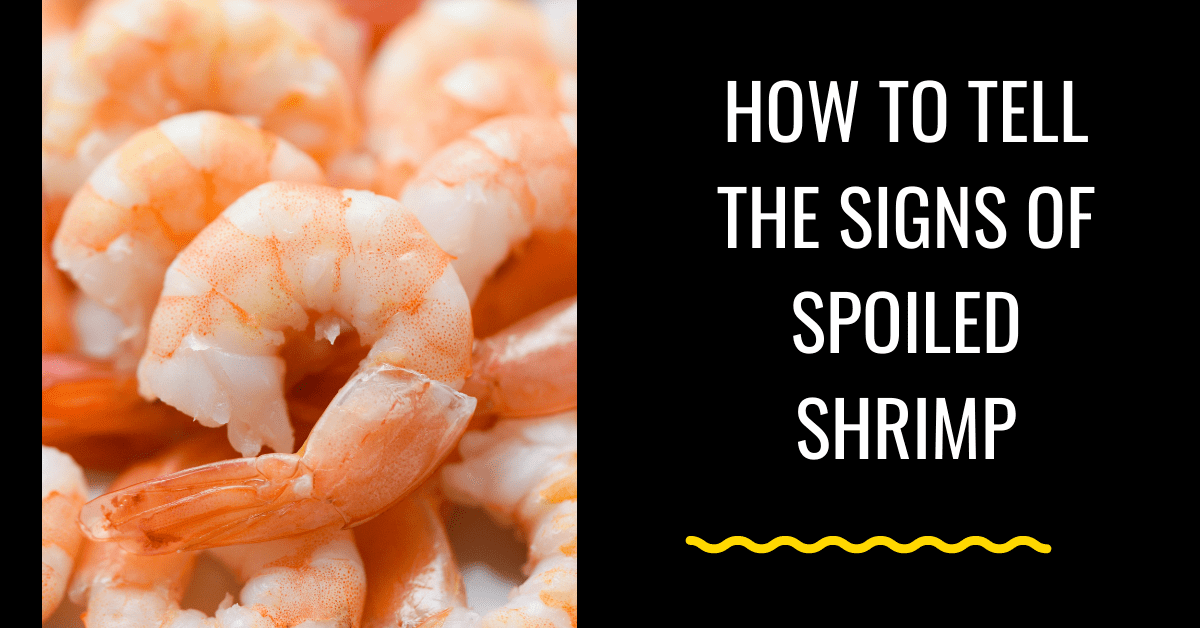How to tell the Signs of Spoiled Shrimp

Key Takeaways
1. Shrimp and prawns are globally loved seafood options that can be interchanged in fisheries and farming, despite minor differences between them in terminology.
2. Shrimp are versatile, delicious, and nutritious, enhancing the flavor of various dishes like fried rice, paella, gumbo, and scampi.
3. Spoiled shrimp may exhibit signs like a fishy smell or freezer burn, indicating spoilage and the need for disposal to avoid foodborne illness.
4. Proper storage, handling, and thawing techniques are crucial for maintaining shrimp quality, including checking for signs of spoilage, observing sell-by dates, and ensuring appropriate temperature control to prevent bacterial growth.
Shrimp and prawn as food:
These are important seafood types liked throughout the world. Shrimps and prawns look the same however, both can be interchanged in wild fisheries and commercial farming.
The difference between them is prawn is a term used for freshwater penaeids whereas, shrimp is used for marine penaeids.
Shrimps are quick, delicious, and nutritious food. The presence of them in the refrigerator increases the option for dinner. The flavor of the dishes like fried rice, paella, gumbo, and scampi is enhanced with the addition of shrimps.
However, if the smell of the shrimp turns fishy or suffers from freezer burn then it must be spoiled and should be removed.
As the shrimp can easily be spoiled so, to avoid this issue they are sold in either frozen form or previously frozen food items. The shelf life of the shrimp is less.
In this article, we will focus on how to tell the shrimp is rotten or bad. So stay with us.
Selecting and Storing Frozen Shrimp:
The raw, frozen, or alive shrimp can be bought. According to studies revealed by the FDA (Food and Drug Administration):
- It must be ensured that the purchased raw shrimp should be placed on ice at the mart.
- The color of the shrimp should be pearl-like with less or no smell.
According to another study, the fresh shrimps are less fresh as compared to the fresh ones. The reason is:
- At the grocery store, the frozen shrimps are sometimes thrown quickly on ice after harvested or caught and remained in frozen form till sold.
- Raw shrimp is frozen on harvesting and defrost before the sale.
- Raw shrimps have more life.
After the studies were done by the FDA, the seafood if left at a warm temperature for a long period before cooking, there are more chances of spoilage.
This mostly happens at the transportation of shrimps from the grocery store to a home or from the fishing port to the grocery store.
To maintain the texture and flavor of the shrimp they will be immediately flash-frozen.
Signs of Spoiled Shrimp:
Every year almost 76 million or more people are affected by food poisoning and consuming rotten and spoiled seafood is the common cause of it.
The symptoms of food poisoning are:
- Diarrhea
- vomiting
Shrimp is a kind of seafood used in many cuisines and it is very important to observe the symptoms of rotten shrimp to keep your health.
- To thaw completely the frozen shrimps are placed in the fridge.
- Defrosting of shrimps is the only way to accurately tell about signs of spoilage.
Spoilage vs. Pathogens:
The spoiled food is not similar to the pathogenic food that cause E. coli or norovirus. The spoilage of food happens when the food is old. The spoilage is felt by smell, taste, and appearance.
The shrimp when not consumed soon enough, you will then observe the changes that are signs of spoilage.
The pathogens can damage the shrimps at any time. They can’t be detected because they don’t cause any changes in smell, taste, or appearance.
Bacteria, viruses, and parasites are included in pathogens and are the reason for different types of ailments.
Spoiled Shrimp Smell:
- Your sense organs are the best way to decide the shrimp is good or bad.
- The shrimp is smelled before purchasing it.
- Plastic coated shrimps can’t be smelled so it is safe to buy fresh shrimp.
- It should have a bit of a salty smell like seawater.
- Throw out the shrimp if it has any sort of unpleasant and strong odor including ammonia, chlorine, and iodine kind of smell.
- These smells are a clear sign of improper preparation or handling or spoilage.
- The off or ammonia smell is because of bacterial growth inside the spoiled shrimp and can be the cause of food poisoning.
Shell Appearance:
- They have hard bodies still connected to the shell.
- The shrimp should be observed.
- They must have clean and clear shells similar to pearls-like color.
- It should be a shiny, glossy, and translucent shell.
- The shelled shrimp should have a smooth shell and attached tightly to the shrimp.
- The bodies within the shell appear loose or have black spots on the shell then the flesh must start to rot from inside.
- The broken and slimy or slippery shells are a sign of spoilage and should not be bought.
- It is again easier to observe by directly looking at fresh and loose shrimp as compared to prepackaged ones.
Shrimp Color:
- The shrimp should be tossed out if the shells are stuck.
- The shrimps should not be discolored on the shells or the head.
- The color of the exposed meat of shrimp should be white or lightly transparent if the heads are cut off.
- The cooked shrimp should be pink in color.
- The rotten or spoiled shrimp appears discolored and this is an indication of spoiled flesh.
- If the shell is gritty or yellow then this is an indication of chemicals like sodium bi-sulfate used for bleaching the shells.
- The chemical might have been used to figure out the older shrimps.
Bad Shrimp Color
Eye Appearance:
- The shrimps bought with their heads on helps you for identification of spoilage.
- The shrimps should have shiny and prominent eyes.
- However, if the eyes look dried out or shrunken you should be able to observe the freshness of shrimp.
Frozen Shrimp Appearance:
- The problems related to shrimps include thawing, freezer burn, and refreezing.
- Indication of any of these issues is frost or ice crystals on the shrimp or in the packaging.
- The storage of shrimp for a long time results in freezer burn.
- The tears on the package is also a sign of this issue.
- The burned shrimp can still be eaten.
- The flavor and texture of the shrimp are affected when stored for a long time in the freezer.
- Before you observe any off smell or other spoiled symptoms, the seafood is safe to eat.
Black spots on Shrimps Meat:
- No need to get worried about black spots on shrimps.
- Studies indicate that sometimes discolored shells of shrimps are known as black spots or melanosis.
- This is not the sign of spoilage or bacteria however, they are the result of enzymatic reaction among sunlight and natural amino acid.
- They still can be eaten.
- To prevent melanosis some shrimps are processed with sulfites.
- If the shrimps are processed with sulphites it should be mentioned on the package to avoid allergens.
- If the head of the shrimp might turn black once they not alive any longer if you buy a shrimp live and in the shell.
- The meat of the shrimp is still safe and fresh to be consumed till only the head has darkened.
Black spots on shrimp meat can indicate a variety of things, but they are typically harmless. Here are a few possible explanations:
- Melanosis: This is the most common cause of black spots on shrimp. It occurs when enzymes in the shrimp react with oxygen, causing melanin to form. Melanosis does not affect the taste or safety of the shrimp, and the spots can be easily removed.
- Black vein: Sometimes, black spots may be caused by the vein running along the back of the shrimp. While unsightly, this vein is not harmful to eat.
- Postmortem pigmentation: After the shrimp dies, pigments in the shell can become more concentrated, leading to the appearance of black spots. This is also harmless.
- Mold or bacterial growth: In rare cases, black spots on shrimp could indicate mold or bacterial growth. If the spots appear fuzzy or have a foul odor, it’s best to discard the shrimp.
It’s essential to properly inspect shrimp before consuming them. If you’re unsure about the safety of the shrimp or notice any signs of spoilage, it’s best to err on the side of caution and avoid eating them.
Check the best date or sell-by date:
- Some bacteria are not detectable with the human senses.
- Don’t rely completely on taste, touch, or smell.
- The Best by Date or Sell by date must be checked to make sure the shrimps are still safe to eat.
- If the shrimps are older than the past dates then avoid eating them.
How long does shrimp last?
The shelf life of shrimp is dependent on several factors like preparation method, sell-by date, and storage conditions. They are enriched with proteins, easy to cook, low in calories and versatile served hot or cold.
The proper handling and storage conditions make the shrimp last long.
Shrimp expiration date:
- Fresh shrimp (Shelled): 1-2 days in the fridge.
- Fresh shrimp (shell on): 2-3 days.
- Cooked shrimp: 3-4 days.
- Frozen shrimp: 4-5 days.
- Canned shrimp: 6-8 months.
If the storage conditions are not proper the shrimps lasts for a shorter period. However, like other proteins, shrimps also have a use-by date, expiration date, or sell-by date.
Storage conditions for shrimps to extend shelf life:
- The shrimp can be kept fresh and longer by storing it properly in the fridge as soon as possible after purchase.
- It should be properly stored in an airtight container to protect from moisture and other pollutants.
- You can freeze a shrimp for a long-term while keeping its taste by using a freezer-safe container.
- The benefits of proper storage of food include cutting food costs, eating healthier, and avoiding waste.
How long the Shrimp is good for when prepared in a dish?
The length of the shrimp’s freshness last depends on the expiring ingredients in a dish and the expiring recipe’s expiring ingredient.
Thawing Frozen Shrimp:
The shrimps can be defrosted in the refrigerator for the whole night or on the shelf for a few hours.
Thawed shrimp should be cooked under 24 hours of thawing for the safe side.
How can you find the freshest shrimp?
- Found on the coast or at shops that mention fresh,
- Seafood caught locally or recently or off-the-boat seafood.
- Wild shrimps are better in taste as compared to farmed ones.
- Find the freshest shrimp in the grocery’s frozen area.
- The shrimp should be observed for freshness before purchasing it other than frozen shrimps as they are packaged already.
How long the shrimp can be refrigerated?
They are highly perishable and for keeping their freshness it must be refrigerated continuously. They are low in fat, delicious, and quickly degrade so the key to get maximum from cooked or fresh shrimp is to properly store them.
The safe food handling procedures must be followed and to avoid spoilage use cooked or raw shrimp.
Uncooked shrimp:
- For the best quality, the raw shrimps can be refrigerated for more than 2 days.
- Always use a plastic wrap or air-tight container for the safe storage of shrimp.
- The shrimps must be placed in the coldest area of your fridge as a common refrigerator is unable to maintain the quality.
- For best quality and storage 32 to 38 degrees Fahrenheit temperature is ideal.
- Place the shrimp in a zippered bag and put it in a bowl of ice for optimum storage.
Cooked Shrimps:
- For more than two days the cooked shrimps can be stored in the fridge.
- They should be stored in air sealed containers.
- The cooked shrimp can be reheated in the microwave or small saucepan steam.
- The quality, texture, and taste are adversely affected when cooked shrimp is frozen for later use.
Safety considerations & Tips:
- The shrimp should be cooked till it is opaque or pearly or has an internal temperature of 145 F.
- To maintain its safety the shrimp must be stored properly as it is a perishable commodity.
- To prevent the growth of bacteria the shrimp must be refrigerated within 2 hours of preparation.
- Refrigerate the shrimp to one hour of preparation if the temperature of the room is above 90 F.
- The dishes must be hot for hot dishes and cold for cold ones during serving.
- Keep shrimp refrigerated all the time to make the raw shrimp last longer in the freezer or fridge.
- The package of the raw shrimps should not be opened until use.
Frozen Shrimp Has Yellow Spots
Yellow spots on frozen shrimp could indicate a few things:
- Melanosis: This is a natural process where enzymes in the shrimp cause a reaction with oxygen, resulting in the formation of black or yellow spots. While not harmful, it can affect the appearance of the shrimp.
- Fat oxidation: Yellow spots can also be a result of fat oxidation, which occurs when the fat in the shrimp reacts with oxygen. This can happen during improper storage or prolonged exposure to air.
- Bacterial growth: In some cases, yellow spots could indicate bacterial growth, particularly if the shrimp has been improperly stored or if it’s past its expiration date.
If the shrimp smells off or if you’re unsure about its safety, it’s best to discard it to avoid any risk of foodborne illness. Additionally, always ensure you’re purchasing seafood from reputable sources and following proper storage and handling guidelines to maintain its quality and safety.
Conclusion:
In this article, we focused on the signs and symptoms of spoiled shrimps. It is a perishable commodity and life can be extended with the proper handling and storage conditions. The sense organs can notice the visible signs of spoilage so discard the food to avoid any ailment.
Frequently Asked Questions:
What does spoiled raw shrimp look like?
The shrimp should be slightly transparent or white and the cooked shrimp should be pink in color. The spoiled shrimp appears to be discolored and that is a clear indication of spoiled flesh. Also, observe the gritty or yellow shell.
Can you get sick with the frozen shrimp?
FDA reported some of the frozen shrimp packages sold nationally are being recalled as they might be affected with salmonella. As there are no reported cases of getting sick from shrimps if the affected bag is bought it should be thrown away or return the package to get a refund.
Why is shrimp bad for you?
The shrimps are high in cholesterol and it is believed to increase the blood cholesterol level and cause heart diseases.
What Is the White Stuff on My Frozen Shrimp?
The white stuff on frozen shrimp is typically ice or frost that has formed during the freezing process. This is completely normal and doesn’t indicate any problem with the shrimp. When shrimp are frozen, moisture inside them can sometimes migrate to the surface and freeze, creating this white frosty layer. It’s essentially freezer burn, which occurs when food is exposed to air in the freezer for an extended period.
While the presence of ice or frost on frozen shrimp isn’t harmful, it can affect the texture and taste of the shrimp if it’s severe. To minimize freezer burn, it’s best to store shrimp in airtight containers or freezer bags to reduce exposure to air. Additionally, using a vacuum sealer can help preserve the quality of frozen shrimp by removing excess air before sealing. If the frost is light and the shrimp otherwise appear normal, they should be safe to eat after proper cooking. However, if the shrimp show signs of freezer burn such as excessive ice crystals or a dry, discolored appearance, they may have degraded in quality, but they are not necessarily unsafe to eat.
What Does Freezer Burned Shrimp Look Like?
Freezer-burned shrimp will typically have noticeable signs of dehydration and deterioration, affecting both their appearance and texture. Here are some common characteristics of freezer-burned shrimp:
- Dry, Leathery Texture: Freezer burn causes moisture loss from the shrimp, resulting in a dry and tough texture. The shrimp may feel leathery to the touch rather than plump and moist.
- Discoloration: Freezer-burned shrimp may appear whitish or grayish in patches or all over the surface. This discoloration is due to the oxidation of the shrimp’s surface tissues.
- Ice Crystals: You might notice the presence of large ice crystals on the surface of the shrimp or within the packaging. This indicates that the shrimp has undergone repeated cycles of freezing and thawing, contributing to moisture loss and deterioration.
- Off Odor: Freezer-burned shrimp may have a stale or off odor, which is a result of the oxidation process. Fresh shrimp should have a clean, briny scent, so any noticeable change in odor may indicate freezer burn or spoilage.
- Brittle or Freezer-Burned Spots: Some parts of the shrimp may become brittle or develop freezer-burned spots, appearing discolored and dry. These areas will lack the natural firmness and elasticity of fresh shrimp.
If you notice these signs on your shrimp, it’s best to discard them as they may have deteriorated in quality and taste. To prevent freezer burn in the future, ensure proper packaging to minimize air exposure and maintain a consistent temperature in your freezer. Vacuum-sealing or using airtight containers can help protect shrimp from freezer burn. Additionally, labeling and rotating your frozen seafood stock can help ensure that you use it before it deteriorates.



